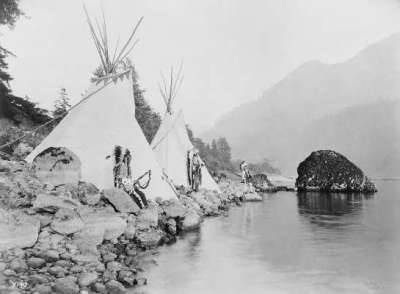Learn what materials were traditionally used to make Native American instruments, and the role these instruments played in ceremonies.
Drums and rattles are the most common instruments used in Native American music. Other percussion instruments include rasps, bells (usually attached to clothing), and clap-sticks. Drums range in size from large powwow drums (played by many people) to the palm-sized water drums found among some Northeastern peoples. Some are constructed from wood with skin heads, or are simply hollowed logs with skin heads, while others require more sophisticated construction techniques. The word "drum" among most Native Americans refers not only to the instrument but to the group of players. There are usually strict codes of conduct governing a drum. Rattles are made from many materials, but gourd or bone is used most frequently. Gourd rattles are made from gourds that have been carefully dried, prepared, and decorated according to personal and/or tribal preference. Bone rattles are most commonly made of a section of a horn that is cut to a desired size. They are also made with the bone left uncut except for a hole at the end so a stick can be inserted to be used as a handle. Gourd and bone rattles are filled with seeds or other objects to produce the desired sound. Turtle rattles are made from the shell of a turtle, with objects such as turtle bones or cherry pits placed inside. This instrument honors the turtle for its role in the creation of "Turtle Island," a name for North America that is frequently used by Eastern Woodlands Native Peoples. Other rattles may be made from such diverse materials as carved wood, cans, and plastic bottles. One particularly popular rattle in the Southwest is made from an aluminum salt or pepper shaker nailed to a handle. Flutes are typically end-blown and constructed as block flutes, similar in construction to a recorder. The air is gently blown into one end, is forced by a blockage up through a fipple, and then goes back into the body of the flute; the pitches change by covering and uncovering finger holes in the body of the flute. The number of finger holes varies from three to six according to tribal and personal preference. Although once used exclusively in courtship or healing, the Native American flute is used in contemporary culture for a variety of purposes and is rapidly gaining popularity among non-Natives. Flutes are usually made from wood (cedar has a particular significance to many peoples) or cane. Examples of ceramic and metal flutes exist, but are not common. Whistles are usually made of bone. The eagle bone whistle is most familiar, although whistles made of antlers, wood, and other animal bones exist. Excerpted from Making Connections: Multicultural Music and the National Standards.





